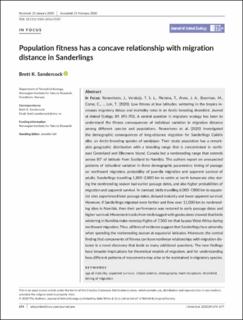| dc.description.abstract | n Focus: Reneerkens, J., Versluijs, T. S. L., Piersma, T., Alves, J. A., Boorman, M., Corse, C., ... Lok, T. (2020). Low fitness at low latitudes: wintering in the tropics in-creases migratory delays and mortality rates in an Arctic breeding shorebird. Journal of Animal Ecology, 89, 691–703. A central question in migratory ecology has been to understand the fitness consequences of individual variation in migration distance among different species and populations. Reneerkens et al. (2020) investigated the demographic consequences of long-distance migration for Sanderlings Calidris alba, an Arctic-breeding species of sandpiper. Their study population has a remark-able geographic distribution with a breeding range that is concentrated in north-east Greenland and Ellesmere Island, Canada but a nonbreeding range that extends across 85° of latitude from Scotland to Namibia. The authors report on unexpected patterns of latitudinal variation in three demographic parameters: timing of passage on northward migration, probability of juvenile migration and apparent survival of adults. Sanderlings travelling 1,800–2,800 km to settle at north temperate sites dur-ing the nonbreeding season had earlier passage dates, and also higher probabilities of migration and apparent survival. In contrast, birds travelling 6,000–7,800 km to equato-rial sites experienced later passage dates, delayed maturity and lower apparent survival. However, if Sanderlings migrated even farther and flew over 11,000 km to nonbreed-ing sites in Namibia, then their performance was restored to early passage dates and higher survival. Movement tracks from birds tagged with geolocators showed that birds wintering in Namibia make nonstop flights of 7,500 km that bypass West Africa during northward migration. Thus, all lines of evidence suggest that Sanderlings face adversity when spending the nonbreeding season at equatorial latitudes. Moreover, the central finding that components of fitness can have nonlinear relationships with migration dis-tance is a novel discovery that leads to many additional questions. The new findings have broader implications for theoretical models of migration, and for understanding how different patterns of movements may arise or be maintained in migratory species | en_US |

